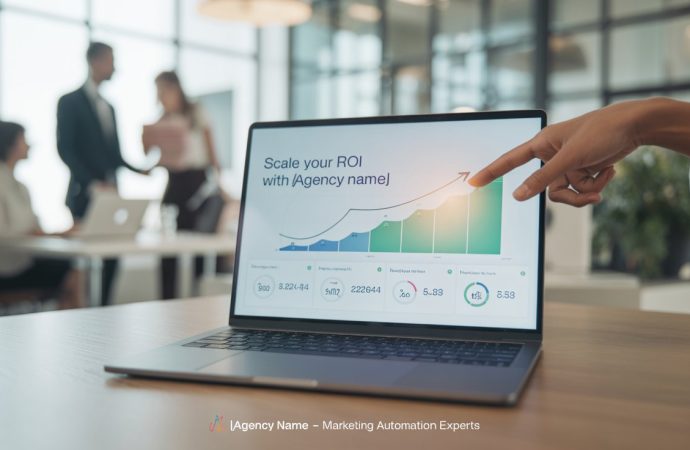When Campaigns Become Systems, Results Multiply Every brand wants to grow, but very few have the structure to do it fast. Growth isn’t just about creativity or big budgets. It’s about systems. Behind many successful digital campaigns today, there’s a hidden driver: a marketing automation agency. This isn’t a trend, it’s a transformation. As traditional
When Campaigns Become Systems, Results Multiply
Every brand wants to grow, but very few have the structure to do it fast. Growth isn’t just about creativity or big budgets. It’s about systems. Behind many successful digital campaigns today, there’s a hidden driver: a marketing automation agency.
This isn’t a trend, it’s a transformation. As traditional agencies struggle to keep up with fragmented channels and fluctuating buyer behavior, automation-led firms are building scalable, repeatable, and trackable marketing systems that drive real return on investment.
What a Marketing Automation Agency Really Does
Most people think of automation as just scheduled emails or chatbots. But what a true marketing automation agency offers is far more complex and effective. It builds a connected layer across every customer touchpoint, ensuring that:
-
Leads are nurtured without manual follow-up
-
Audiences are segmented dynamically
-
Campaigns are adjusted based on behavior, not guesswork
-
Performance is tracked in real time across channels
This structure transforms marketing from a series of one-off tasks into an ecosystem that runs 24/7.
The ROI Problem Most Businesses Face
Brands often face one of two problems:
-
They generate traffic but can’t convert it consistently
-
They collect leads but lose them due to poor follow-up
The cause is usually the same: a lack of aligned strategy across email, content, social media, ads, and CRM. A marketing automation agency fixes this by linking all moving parts so they respond in sync to each buyer’s actions.
Instead of blasting everyone with the same message, automation ensures the right person sees the right content at the right time.
What Powered This ROI Surge
Let’s explore how a real marketing automation agency scaled ROI across client campaigns. The shift came from implementing five major components.
Smart Lead Segmentation
The first step was setting up audience filters that could adjust in real time. Instead of manually tagging leads or assigning lists, automation tools were configured to:
-
Score leads based on behavior
-
Move leads between funnels dynamically
-
Send tailored content based on actions taken
This made every message more relevant, improving open rates and click-throughs without increasing ad spend.
Cross-Platform Integration
Results improved dramatically when disconnected platforms were finally connected. CRM data, website analytics, ad metrics, and email behavior were all fed into one dashboard.
This allowed the agency to:
-
View the full journey of a lead
-
Identify weak points in the funnel
-
Optimize campaigns using live insights
With visibility came precision—and with precision came higher ROI.
Email Automation With Lifecycle Mapping
A big win came from shifting email from blast-based to behavior-based. Automation flows were mapped across customer lifecycles, including:
-
Welcome series for new signups
-
Abandoned cart recovery for e-commerce
-
Upsell offers after key purchases
-
Re-engagement campaigns for inactive users
These sequences ran in the background, generating conversions without day-to-day input.
Ad Retargeting Based on CRM Behavior
Instead of showing retargeting ads to everyone who visited a page, the agency used CRM-linked behavior to serve ads only to qualified leads. This lowered ad costs and improved conversion rates.
Dynamic retargeting campaigns were personalized based on:
-
Pages visited
-
Time spent
-
Email clicks
-
Purchase history
With better audience filters, campaigns became cheaper and smarter.
Reporting That Informed Real Decisions
No campaign was run blindly. With custom reporting dashboards, the agency could show:
-
ROI per channel
-
Lead source performance
-
Email automation impact
-
Retargeting return
This built client confidence and allowed budget allocation to shift quickly based on what worked.
Tools Behind the Success
While every agency uses different software, the success hinged more on how tools were used than which ones were picked. Key categories included:
-
CRM platforms (HubSpot, Zoho, Salesforce)
-
Email automation (Active Campaign, Mailchimp, Klaviyo)
-
Ad platforms (Meta Ads, Google Ads)
-
Web tracking (Hotjar, Google Analytics)
-
Dashboard builders (Data Studio, Agency Analytics)
But none of these worked in isolation. The agency’s role was to tie everything together into a functional system tailored to each client’s business model.
Services a Marketing Automation Agency Typically Offers
Not every client needs everything. Agencies usually provide services like:
-
Strategy building
-
Platform setup and integration
-
Workflow design and testing
-
Lead scoring models
-
Campaign execution and optimization
-
A/B testing
-
Monthly analytics and performance review
Clients may opt for full-service partnerships or targeted fixes depending on their in-house capabilities.
The Shift From Manual to Automated Isn’t Just About Time
It’s easy to think automation is only about saving effort. But the real advantage lies in consistency and personalization. Manual marketing:
-
Misses follow-ups
-
Sends messages too early or too late
-
Lacks unified insights
-
Treats all leads the same
An automation agency corrects this by giving structure to scale, and in turn, delivering better customer experiences at lower operational costs.
How Automation Impacts the Customer Journey
At every touchpoint, automation adds value:
| Stage | Without Automation | With Automation |
|---|---|---|
| Awareness | Generic ads | Dynamic ads based on interests |
| Consideration | Inconsistent follow-ups | Timed emails with targeted content |
| Conversion | One-size-fits-all offers | Smart discounts based on lead score |
| Retention | Manual check-ins | Scheduled engagement and loyalty flows |
| Referral | No system to ask for reviews | Automated feedback and referral prompts |
This systematization makes a difference not just in conversion, but in long-term value per customer.
Why Businesses Now Choose Automation Agencies
Traditional marketing agencies still have value, especially in branding and creative work. But when businesses seek predictability and ROI, they often turn to automation-first firms.
Benefits include:
-
Measurable performance
-
Faster scaling
-
Lower cost per acquisition
-
Higher lead conversion rate
-
Reduced dependency on large in-house teams
This shift is why marketing automation agency models are rising in popularity, especially among growth-focused startups and mid-sized companies.
Common Challenges Agencies Solve
Marketing automation isn’t a plug-and-play solution. Many businesses attempt it in-house and face challenges like:
-
Poor integration between tools
-
Lack of segmentation strategy
-
Generic email flows that underperform
-
Reporting confusion due to data silos
Agencies solve these by offering end-to-end setup and ongoing optimization based on real outcomes.
A Look at the Future
The next phase of marketing automation will likely include:
-
AI-generated campaign variants
-
Predictive lead scoring
-
Deeper personalization with zero-party data
-
Voice and WhatsApp-based automation
-
More integration with sales teams for unified CRM flows
Agencies leading this shift won’t just automate—they’ll humanize digital interaction at scale.
The ROI Blueprint Is Now a System
Achieving consistent returns on marketing investment is no longer a guessing game. It’s a system—a carefully mapped set of interactions that align platforms, messages, and behaviors. And building that system is the core offering of a marketing automation agency.
For businesses seeking to grow fast, stay lean, and reduce acquisition costs, this agency model isn’t just an option—it’s a roadmap.
















